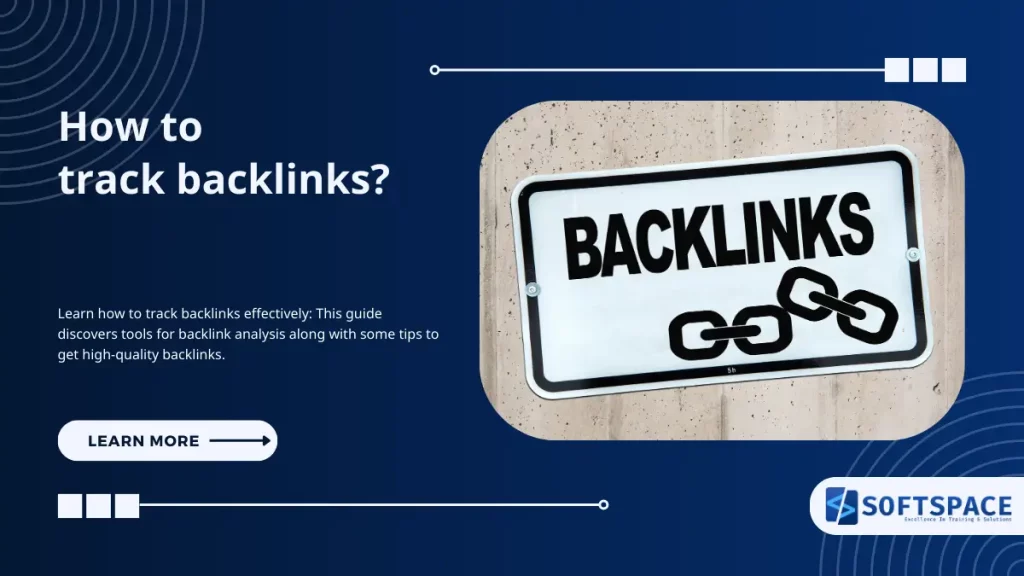In the fast-changing world of SEO, backlinks remain one of the most powerful ranking signals. So, how to track backlinks and their impact? In 2025, their role is more important than ever. As search engines become smarter with the help of Artificial Intelligence Optimisation (AIO), they focus more on contextual relevance, content quality, and human-like signals such as trust and authority. Backlinks are key to all three.
But it’s not just about gaining links; it’s about knowing how to track backlinks effectively. Whether you’re managing a large SEO project or growing a personal blog, tracking your backlink profile helps you measure impact, spot new chances, protect your site from harmful links, and stay competitive in your field.
In this blog, you’ll learn:
- Why backlinks still matter in an AI-driven SEO environment?
- How to track backlinks step-by-step using modern tools?
- What metrics to monitor for link quality and performance?
- How to adjust your strategy with Google’s changing ranking systems?
- Pro-level tactics to future-proof your backlink profile
If you want to create a strong, sustainable link strategy that thrives in 2025 and beyond, mastering backlink tracking isn’t optional; it’s essential.

The Two Primary Categories of Backlinks
Do-Follow Backlinks
These are the top tier of link building. They pass link equity from the referring site to yours, which directly affects your search engine rankings. Search engines see these as real endorsements of your content.
No-Follow Backlinks
While these links don’t directly affect rankings due to the rel="nofollow" tag, they still hold value. They help create a natural link profile, drive referral traffic, and boost brand visibility online.
Why Backlinks Remain Critical in 2025?
The digital marketing field has seen many changes, with artificial intelligence altering search algorithms. Yet, backlinks still act as key ranking signals because they show real human approval of content quality.
Key Benefits Include:
- Improved Search Rankings: Quality backlinks are still among Google’s top three ranking factors.
- Increased Organic Visibility: Websites with strong backlink profiles get 3.8 times more organic traffic than those without.
- Faster Indexing: Search engine crawlers find new content quickly through existing backlinks.
- Referral Traffic Generation: Visitors from linking sites often show higher engagement rates.
- Brand Authority Building: Regular mentions across trusted sites build industry credibility.
How to track backlinks? The Critical Importance
Backlink tracking means monitoring and analysing all links coming to your website. This process includes finding new backlinks, watching for lost links, checking link quality, and seeing how these aspects affect your SEO performance.
Why Professional Backlink Tracking Matters
1. Performance Improvement
Regular tracking shows which content attracts the best backlinks. This helps you repeat successful strategies and use resources wisely.
2. Risk Management
Spotting harmful links early can prevent penalties from algorithms that could hurt your search rankings. Google’s smart spam detection can punish sites with questionable link profiles.
3. Competitive Insight
Learning about your competitors’ backlink strategies can show you untapped opportunities and industry trends before they become common.
4. ROI Measurement
Tracking allows you to measure the effectiveness of your link-building campaigns. This ensures your marketing budget delivers clear results.
5. Relationship Building
Monitoring who links to your content reveals potential partnership opportunities and industry influencers to engage with.
Types of Backlinks: Understanding the Link Ecosystem
Editorial Backlinks (Natural Links)
The Holy Grail of Link Building
Editorial backlinks appear when content creators cite your material because it genuinely benefits their audience. These links often show up in the main text of articles, blog posts, or research papers.
Characteristics:
- Relevant anchor text
- Surrounded by related content
- From trusted sources in your area
- Real endorsements
Guest Post Backlinks
Strategic Content Partnerships
These links come from contributing valuable content to other websites in your field. When done right, guest posting builds relationships and showcases your expertise.
Best Practices:
- Target sites with active audiences in your niche
- Create unique, high-value content
- Use natural variation in anchor text
- Focus on building real relationships, not just collecting links
Directory Backlinks
Industry-Specific Listings
Quality directory backlinks come from well-respected industry groups, local business directories, and professional organisations. Focus on quality and steer clear of poor directory farms.
Valuable Directory Sources:
- Industry association member directories
- Local Chamber of Commerce listings
- Professional certification bodies
- Niche-specific trade directories
Social Media Backlinks
Amplification and Discovery
While most social media links are no-follow, they play an important role in promoting content. They can lead to editorial mentions from creators who discover your material via social channels.
UGC (User-Generated Content) Backlinks
Community-Driven Links
These links carry the rel="ugc" tag and come from user contributions such as forum discussions, review sites, and community platforms. They offer useful brand mentions and can drive targeted traffic.
Sponsored Backlinks
Transparent Paid Partnerships
Links marked with rel="sponsored" indicate paid partnerships or ads. While they don’t pass SEO value, they can improve brand visibility and attract qualified traffic when on relevant platforms.
Toxic Backlinks (To Avoid)
Link Profile Threats
These damaging links can hurt your search rankings, so identify and disavow them quickly:
- Links from penalised domains
- Excessive footer or sidebar links
- Links from unrelated fields
- Artificially produced links from private blog networks (PBNs)
How to track backlinks with modern tools?
Your link profile is like a Google Rating for your website. High-quality backlinks will enhance your Domain Rating, and low-quality backlinks will drop your rating. So, to keep a track, you have to have a sound team to keep track of incoming and outgoing links.
During this task, you will face the question, “How to track backlinks?” And what’s the answer? Some very recommended tools as listed below:
Backlink Tools — Quick Comparison
| Tool | Key Features | Pricing | Link |
|---|---|---|---|
| Ahrefs | Comprehensive backlink index (updates frequently), anchor text analysis, toxic link detection, content gap & competitor backlink research. | $129/month | View pricing |
| SEMrush | Integrated SEO/PPC suite, backlink analytics, brand mention monitoring, outreach templates and position tracking. | $117.33/month | View pricing |
| Moz Pro | Domain Authority metric, Link Explorer spam analysis, link intersect, SERP feature tracking and local SEO tools. | $49/mo | View pricing |
| Majestic | Historical backlink index, Trust & Citation Flow metrics, bulk backlink exports and API access for integrations. | $49.99/month | View pricing |
| Google Search Console | Verified links from Google’s index, internal link reports, Core Web Vitals, search performance and mobile usability insights. | Free | View page |
| Ubersuggest | Budget-friendly backlink checks, competitor research, content ideas, site audits and rank tracking for smaller teams. | ₹985.42/month | View pricing |
How To Track Backlinks Step-by-Step?
Step 1: Establish Your Baseline
Document Your Current Link Profile
Start by auditing your existing backlink profile. This assessment will help you measure future progress and spot immediate opportunities or threats.
Action Items:
- Export complete backlink data from your chosen tracking tool
- Categorise links by type (editorial, guest post, directory, etc.)
- Assess the domain authority and relevance of linking sites
- Identify potentially harmful links that need disavowal
- Document anchor text distribution patterns
Step 2: Set Up Automated Monitoring
Create Systematic Tracking Systems
Set up automated monitoring systems that will alert you to new backlinks, lost links, and potential issues that need immediate attention.
Configuration Steps:
- Set up daily email alerts for new backlinks
- Create monthly reports for thorough analysis
- Configure competitor backlink monitoring
- Establish branded mention tracking
- Set up Google Alerts for unlinked brand mentions
Step 3: Analyse Link Quality and Relevance
Evaluate Each Backlink’s Value
Not all backlinks hold the same value. Develop a method to assess the quality and relevance of each link pointing to your site.
Quality Assessment Criteria:
- Domain Authority: Higher authority sites pass more value
- Topical Relevance: Links from related industries carry more weight
- Traffic Volume: Sites with engaged audiences provide referral value
- Link Placement: In-content links outperform footer or sidebar placements
- Anchor Text Naturalness: Varied, contextual anchor text appears more natural
Step 4: Monitor Competitor Strategies
Competitive Intelligence Gathering
Regular competitor analysis helps you discover successful link-building strategies and potential partnerships in your industry.
Competitor Analysis Framework:
- Identify 5 to 10 top competitors in your niche
- Analyse their most valuable backlinks monthly
- Spot linking domains that do not link to you
- Monitor their content strategies that attract links
- Track their anchor text distribution patterns
Step 5: Regular Link Profile Maintenance
Ongoing Optimisation and Protection
Keep your backlink profile healthy through regular audits, removal of toxic links, and outreach to strengthen existing relationships.
Monthly Maintenance Tasks:
- Review and disavow toxic backlinks
- Contact websites with broken links to your content
- Update outdated contact information in directory listings
- Follow up with guest posting partners for additional chances
- Monitor for negative SEO attacks or unusual link patterns
Advanced Strategies for Quality Backlink Acquisition
Content-Led Link Earning
Creating Linkable Assets
The best way to acquire backlinks is to create content so valuable that other websites want to reference it.
High-Impact Content Types:
- Original Research and Data Studies
- Comprehensive Resource Guides
- Interactive Tools and Calculators
- Visual Content and Infographics
- Case Studies and Success Stories
Strategic Influencer Outreach
Building Authentic Relationships
Successful influencer outreach focuses on building genuine relationships instead of just asking for links.
Outreach Best Practices:
- Research thoroughly
- Personalize communications
- Provide value first
- Follow up professionally
- Track relationship development
Broken Link Building
Turning Problems into Opportunities
This strategy involves finding broken links on relevant websites and suggesting your content as a replacement.
Implementation Process:
- Use tools like Ahrefs or Screaming Frog to find broken links
- Create or identify replacement content
- Craft personalised outreach emails
- Follow up with non-responders
- Track success rates and optimise your approach
Resource Page Link Building
Targeting Curated Content Collections
Many websites have resource pages linking to valuable tools and content. These offer great link-building opportunities.
Targeting Strategy:
- Search for niche-specific resource pages
- Analyse existing links for quality standards
- Ensure your content meets or exceeds those standards
- Craft compelling pitches
- Build relationships with page maintainers
AIO-Optimised Backlink Monitoring
Understanding AIO (Artificial Intelligence Optimisation)
Preparing for AI-Driven Search
As search engines increasingly use AI to understand content and user intent, backlink strategies must evolve accordingly.
AIO Considerations for Backlinks:
- Context and relevance between linking and linked content
- User experience signals such as engagement and bounce rates
- Entity recognition for brand authority
- Overall content quality of both pages
- NLP insights from anchor text and surrounding content
AI-Enhanced Link Prospecting
Leveraging Machine Learning for Efficiency
AI-Driven Prospecting Methods:
- Predictive analytics to identify high-potential sites
- Content similarity analysis
- Automated outreach personalisation
- Sentiment analysis for engagement likelihood
- Pattern recognition for successful strategies
Preparing for Voice Search Impact
Optimising for Conversational Queries
As voice searches start dominating, backlinks from content optimised for conversational queries become more and more valuable.
Voice Search Optimisation Strategies:
- Target websites that answer specific user questions
- Focus on local and “near me” backlinks
- Build links from FAQ and Q&A platforms
- Address long-tail, conversational queries
- Optimise for featured snippets
Common Pitfalls and How to Avoid Them
Quantity Over Quality Mentality
The Volume Trap
Valuing the number of backlinks over their quality is a common mistake.
Warning Signs:
- Accepting irrelevant links
- Joining link exchange schemes
- Buying links in bulk
- Chasing Domain Authority without relevance
Solution: Create and follow strict quality guidelines.
Ignoring Anchor Text Distribution
The Over-Optimisation Problem
Best Practices for Anchor Text:
- 70% branded or natural phrases
- 20% partial match keywords
- 10% exact match keywords (or less for competitive terms)
Neglecting Link Maintenance
The Set-and-Forget Mistake
Maintenance Essentials:
- Monthly broken link audits
- Quarterly quality assessments
- Annual profile reviews
- Quick responses to algorithm updates
Insufficient Competitor Analysis
Missing Market Opportunities
Not keeping an eye on competitor backlink strategies means losing valuable opportunities and insights.
Competitive Intelligence Framework:
- Weekly monitoring of competitor backlinks
- Monthly link-attracting content analysis
- Quarterly industry trend assessments
- Annual in-depth backlink audits
Future-Proofing Your Backlink Strategy
Emerging Trends to Monitor
- AI-Generated Content Integration
- Video and Multimedia Link Building
- Local SEO and Hyperlocal Targeting
- E-A-T (Expertise, Authoritativeness, Trustworthiness)
- Core Web Vitals Integration
Building Sustainable Link Ecosystems
Long-term Relationship Focus
Content Partnership Development
Create recurring value with strategic partnerships across your industry.
Community Building and Engagement
Engage actively in forums, associations, and online communities.
Thought Leadership Establishment
Establish expertise through research, speaking, and media presence.
Measuring Long-Term Success
Beyond Rankings Metrics
- Brand mentions and sentiment
- Referral traffic quality and conversions
- Industry recognition and awards
- Media opportunities and speaking invites
- Professional network growth
ROI-Focused Assessment
- Customer lifetime value from referral traffic
- Lead quality from backlink sources
- Brand awareness metrics
- Partnership opportunities generated
- Thought leadership recognition
Conclusion: Your Path to Backlink Mastery
Effective backlink tracking and acquisition are still crucial for SEO success in 2025. However, strategies and tools have changed significantly, requiring a smarter approach that focuses on quality, relevance, and genuine relationship building.
Key Takeaways:
- Quality Always Trumps Quantity: One great link beats 100 weak ones
- Systematic Tracking is Essential: Use tools to stay on top of changes
- Relationship Building Beats Link Buying: Earn trust, not transactions
- AI Integration is the Future: Adapt to smarter search engines
- Maintenance is Mandatory: Clean up regularly to avoid penalties
The digital landscape will keep evolving, but websites that focus on creating genuinely valuable content and building authentic relationships will always attract high-quality backlinks.
Remember: Successful backlink building is a marathon, not a sprint. Consistency, quality, and patience will lead to sustainable results for your website.
Ready to improve your backlink strategy?
Start with a complete audit of your current link profile using the tools and techniques outlined above. Your future search rankings depend on what you do today.

13+ Yrs Experienced Career Counsellor & Skill Development Trainer | Educator | Digital & Content Strategist. Helping freshers and graduates make sound career choices through practical consultation. Guest faculty and Digital Marketing trainer working on building a skill development brand in Softspace Solutions. A passionate writer in core technical topics related to career growth.



